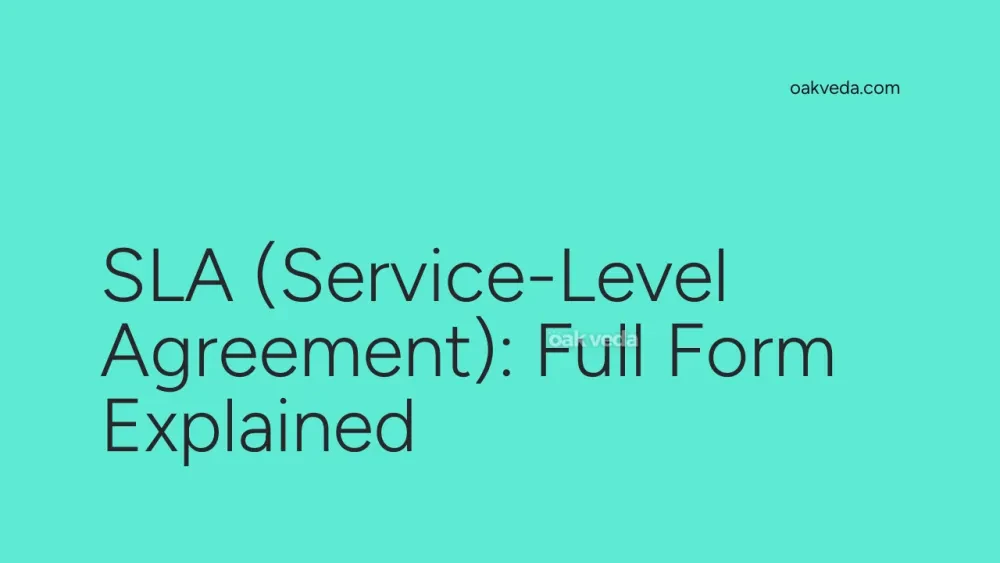
What is the Full Form of SLA?
The full form of SLA is Service-Level Agreement. This crucial document outlines the commitment between a service provider and a customer regarding the quality and standards of service delivery. SLAs play a vital role in establishing clear expectations and ensuring accountability in various business relationships.
What is a Service-Level Agreement?
A Service-Level Agreement (SLA) is a formal contract that defines the specific services a provider will deliver to a client, along with the performance standards and metrics by which these services will be measured. It serves as a blueprint for the service relationship, detailing everything from service quality and availability to responsibilities and penalties for non-compliance.
Origin and Development of Service-Level Agreements
Service-Level Agreements emerged in the late 1980s as the IT industry began to mature and outsourcing became more prevalent. Initially, SLAs were primarily used in technology-related services but have since expanded to cover a wide range of industries and service types. The concept has evolved to become a standard practice in business-to-business (B2B) and business-to-consumer (B2C) relationships, ensuring transparency and setting clear expectations for service delivery.
How does a Service-Level Agreement work?
An SLA works by establishing a clear framework for service delivery and performance evaluation. Here's a breakdown of its typical components:
- Service description
- Performance metrics
- Reporting and monitoring procedures
- Problem management processes
- Customer duties and responsibilities
- Disaster recovery plans
- Agreement termination clauses
- Penalties for breach of contract
These elements collectively create a comprehensive guide for both the service provider and the customer, ensuring that all parties understand their roles and obligations.
Types of Service-Level Agreements
SLAs can be categorized into several types based on their scope and application:
- Customer-based SLA: Tailored for individual customers or groups
- Service-based SLA: Applies to all customers using a particular service
- Multilevel SLA: Addresses different levels of service for various customer groups
- Internal SLA: Used within an organization to manage interdepartmental services
- Operational Level Agreement (OLA): Defines how different IT groups work together to meet SLA requirements
Functions of Service-Level Agreements
The primary functions of an SLA include:
- Setting clear expectations for service delivery
- Defining measurable standards for performance evaluation
- Establishing communication channels and procedures
- Outlining problem resolution processes
- Providing a framework for continuous service improvement
- Protecting both the service provider and the customer
Applications of Service-Level Agreements
SLAs are widely used across various industries and services, including:
- IT services and cloud computing
- Telecommunications
- Internet Service Providers (ISPs)
- Managed service providers
- Outsourcing agreements
- Customer support and call centers
- Facilities management
- Healthcare services
Features of Service-Level Agreements
Key features of an effective SLA include:
- Clarity: Written in plain language to avoid misinterpretation
- Specificity: Detailed description of services and performance metrics
- Measurability: Quantifiable standards for evaluating service quality
- Flexibility: Provisions for reviewing and updating the agreement
- Enforceability: Clear consequences for non-compliance
- Relevance: Tailored to the specific needs of the customer and service
Benefits of Service-Level Agreements
Implementing SLAs offers numerous advantages:
- Improved customer satisfaction through clear expectations
- Enhanced accountability for service providers
- Better resource allocation and planning
- Reduced conflicts and misunderstandings
- Continuous improvement of service quality
- Increased trust and transparency in business relationships
- Standardization of service delivery processes
Limitations or Challenges of Service-Level Agreements
While SLAs are valuable tools, they do have some limitations:
- Can be time-consuming and complex to develop
- May require frequent updates to remain relevant
- Can lead to a focus on metrics rather than overall service quality
- Potential for unrealistic expectations if not carefully negotiated
- Difficulty in measuring certain qualitative aspects of service
Future Developments in Service-Level Agreement Technology
As technology evolves, so do SLAs. Future trends in SLA development include:
- AI-driven SLAs: Utilizing artificial intelligence for real-time monitoring and adjustment of service levels
- Blockchain-based SLAs: Implementing smart contracts for automated enforcement and transparency
- Dynamic SLAs: Agreements that adapt in real-time to changing business needs and conditions
- Experience Level Agreements (XLAs): Focusing on user experience rather than just technical metrics
- Integration with IoT: Leveraging Internet of Things devices for more accurate performance monitoring
FAQs on SLA Full Form
-
What is the primary purpose of an SLA? The primary purpose of an SLA is to define the level of service expected by a customer from a service provider, document the metrics by which that service is measured, and outline the remedies or penalties if the agreed-upon levels are not achieved.
-
How often should an SLA be reviewed? SLAs should be reviewed regularly, typically annually, to ensure they remain relevant and aligned with evolving business needs and technological capabilities.
-
Can SLAs be used in non-technical industries? Yes, while SLAs originated in the IT industry, they are now widely used across various sectors, including healthcare, logistics, and professional services.
-
What happens if an SLA is breached? If an SLA is breached, the consequences typically include penalties for the service provider, which may be financial compensation, service credits, or other remedies as specified in the agreement.
-
How do SLAs benefit customers? SLAs benefit customers by providing clear expectations for service quality, establishing accountability, and offering recourse if service levels are not met, ultimately leading to improved service delivery and customer satisfaction.
You may be interested in:

